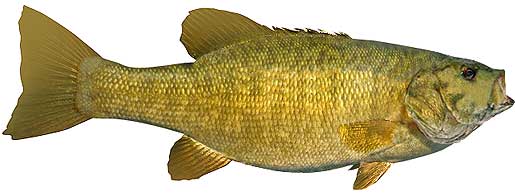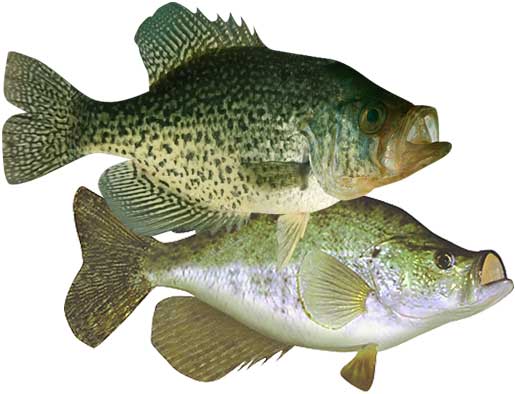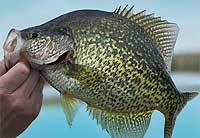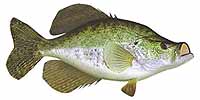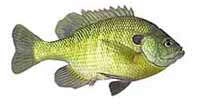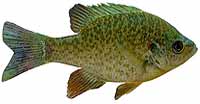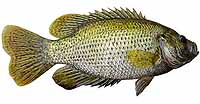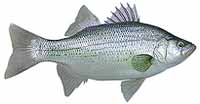Fishing Report For Fort Loudoun Lake, TN
By Rick Seaman
September 19, 2025
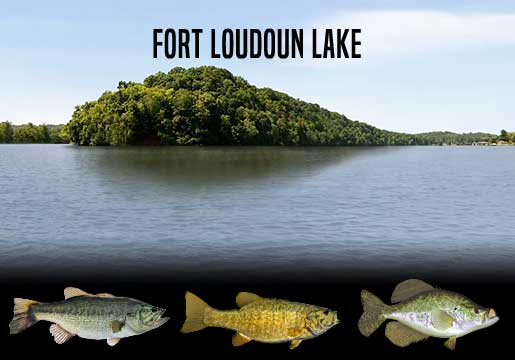
Fishing Reports
Popular Fish Species Fort Loudoun Lake, TN
Largemouth Bass
Current Report: Good To Very Good
FALL. With the arrival of Fall, bass here are moving shallow and following schools of baitfish into coves and shallow bays into 4 to 15 feet of water. Currently jerkbaits, crankbaits, vibrating jigs, and slow-rolled spinnerbaits are catching bass. Later in Fall, as deeper water cools, bait and bass move out to ledges, channel edges, points and humps where flutter spoons, big worms and jigs are often good choices.
WINTER. Winter will isolate them around slightly deeper structure, flats, points and creek channels. They can be found from 20 to 30 feet deep, or deeper. Here they hold, feeding less frequently, awaiting warmer water to return in Spring. Slow presentations work best on these inactive fish.
SPRING. Once water temperatures rise into the low 60's, largemouth will move from deep wintering holes, to shallower water nearby spawning areas. Vibrating jigs, jerkbaits, buzzbaits, and spinnerbaits, fished in 2 to 8 feet of water, typically get bites. At this time they will be feeding aggressively and preparing for the spawn. Once water warms into the mid to high 60's, they will move into 1 to 4 feet of water, and create nests, then lay their eggs. Immediately afterwards, females move to deeper water and males remain to guard the eggs, and then the fry. After a couple weeks, the males also move to slightly deeper water. Crankbaits, vibrating jigs, plastic worms and swimbaits are catching bass during this period.
SUMMER. Water temperatures will warm considerably in Summer. Bass will feed shallow, early and late in the day, where they will be caught on topwater, crankbaits and swimbaits. Largemouth bass here feed on gizzard shad, threadfin shad, small sunfish and crawfish. During the hotter parts of the day, they are being caught on points, channel edges, and ledges 12 to 20 feet deep. The best reports seem to be from anglers fishing around submerged timber along these depth changes.
Smallmouth Bass
Current Report: Good To Very Good
FALL. As Fall arrives, smallmouth follow baitfish into coves and bays 5 to 10 feet deep. This is where jerkbaits, crankbaits, and slow-rolled spinnerbaits, are quite successful. The average fish being caught averages about 1 1/2 to 2 pounds, but plenty of 3 to 4 pound smallies are often caught.
WINTER. Winter isolates smallmouth around deeper structure, points and creek channels, often suspending in open water above these features. They can generally be found from 20 to 35 feet deep. Here they hold, feeding less aggressively while they wait for warmer water to return in Spring. Fishing shallow for smallmouth is often good on cold, windy, cloudy and rainy days.
SPRING. When water temperatures rise into the 50's now, smallmouth will have moved from deep wintering spots to shallower water, nearby spawning areas. They feeding heavily in 5 to 15 feet of water at this time, and are typically caught on jerkbaits, crankbaits, tube baits, Ned rigs, and crayfish imitating plastics. Once water warms into the high 50's, they move into 2 to 6 feet of water, and create nests in rocky, gravel, rip rap or sand areas, where they lay their eggs. Females then move to deeper water and males remain to guard the eggs, and then the fry. After a couple weeks, the males also move to 15 to 25 feet deep, and feed aggressively. Crankbaits, tube baits, Ned rigs, plastic worms, spoons and swimbaits are catching smallies during this period.
SUMMER. Smallmouth bass, including a few trophy-size gems, typically feed shallow, early and late in the day where they are reportedly caught on topwater, crankbaits, swimbaits, Ned rigs and tube baits. Smallmouth bass here feed on crawfish, threadfin shad, gizzard shad, and small sunfish. They prefer rocky, rip rap, or gravel bottom areas, as this is where crayfish live. During the hotter parts of the day, they are being caught on points, humps, and ledges 15 to 25 feet deep. Often these deeper fish are part of a school of smallmouth.
Black & White Crappie
Current Report: Good To Very Good
FALL. Baitfish, which are moving into shallow flats, creek arms and bays, are drawing crappie into these areas. They are feeding heavily in preparation for the cold Winter. Minnows, hair jigs, and crappie jigs, are good options fished in 5 to 15 feet of water around cover. Late fall starts the migration deeper to 20 or 25 feet, around winter holding areas, for both crappie and baitfish. Small flutter spoons, jigs and minnows are good options during this transition
WINTER. Once the shallows start cooling rapidly, crappie will migrate to deeper holding areas, mostly off shore. At this time they are typically caught using a very slow presentation, in 20 to 25 feet of water. If they are suspending in open water, they often relate to some cover, or structure change, directly below them.
SPRING. In early Spring, crappie begin staging in 5 to 8 feet of water, just outside spawning bays and shallow flats. Spring is prime time to be on the water, as crappie have moved shallow to spawn. At that time, they are typically nesting in 2 to 8 feet of water. Vegetation, docks, brush and wood are where most anglers catch crappie using small crappie jigs or live minnows. After the spawn, crappie typically move outside the spawning area and hold on cover, close by. Once they move even deeper, anglers report success using fish finders and forward facing sonar to locate schools of crappie, which tend to stack vertically around cover. Light tackle, with 4 lb to 8 lb line, is a popular choice.
SUMMER. Water temperatures warm, and crappie fishing is usually pretty good. Now that the spawn is over, and the hot Summer sun is warming the shallows, crappie have retreated to depths of 12 to 20 feet, or embedded in the shade of heavy vegetation. This is a good time to focus around deeper docks and brush piles. Anglers are also locating schools of crappie hanging over deep structure and around creek channel edges.
Fishing Video
Fish species to fish for...
Guide to fishing for largemouth bass, smallmouth bass, spotted bass, channel catfish, blue catfish, black crappie, white crappie, walleye, bluegill, redear sunfish, rock bass, warmouth, white bass, striped bass, hybrid striped bass, paddlefish and sauger at Fort Loudoun Lake in Tennessee.
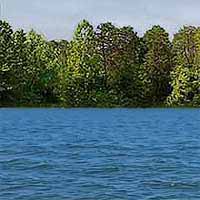
Fort Loudoun Lake is a 14,500-acre reservoir with about 380 miles of shoreline. Bass, crappie, walleye, sunfish, white bass, stripers, catfish, sauger and sunfish. There are numerous spots around the lake for fishing from the bank.
Primary fish species to catch
Click images for fishing tips and details about each species.
Today's Weather & Forecast
Fishing Boat Rentals
Click here for fishing boat rentals.
Marinas
Click here for marinas.
Public Boat Launch Ramps & Landings
Click here for boat ramps.
Fishing License
Click here for a Tennessee Fishing License.
Map - Fishing & Access
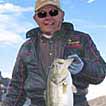
Rick Seaman is a fishing enthusiast with over five decades of fishing experience, a retired tournament fisherman, author of numerous published articles on fishing, and co-author of the book "Bass Fishing - It's not WHAT you throw, It's WHERE you throw it".
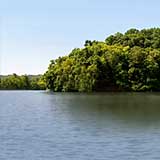
Contact Information
Tennessee Valley Authority
400 West Summit Hill Drive
Knoxville TN 37902
865 632-2101
Fishing lakes in each state
092025
Fort Loudoun Lake, TN Report
TENNESSEE


Crappie, bass and walleye fishing in east-central TN.









